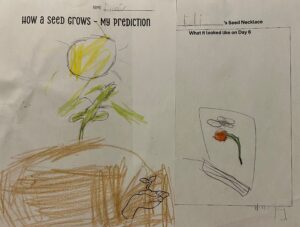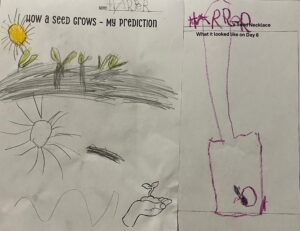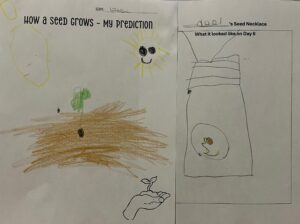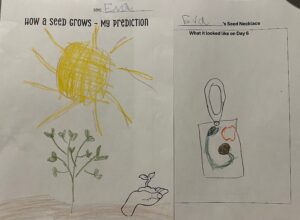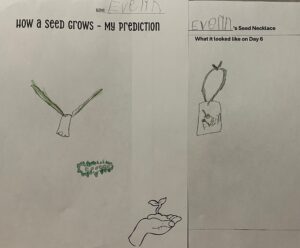Kindergarten – Science – Introduction to Parts of a Plant
Below is a multi-day lesson I did with my Kindergarten students during my Internship. We started with a story, predictions, and planting our Living Necklaces. Then, over the next week and a half, we checked in on our necklaces to see how they were growing and looking for how our seeds were changing. Our necklaces were hanging in a spot in the classroom so students could go check in on them throughout the day. We had small conversations about the things we have noticed that are different. Then, finally, about a week and a half later, we looked at our predictions and our living necklaces and compared them. As a class, we labelled the parts of the plant that we saw in our living necklaces and talked about what the parts were. Then, I had students draw a picture of their necklaces to compare to their predictions. Finally, we planted our seeds in the dirt so we could continue to take care of them, watch them grow, and eventually eat the peas!
| Subject/Grade: Kindergarten Science
Lesson Title: Intro to Parts of the Plant – Living Necklaces |
||
| Stage 1: Identify Desired Results | ||
| Outcome(s)/Indicator(s):
LTK.1 – Examine observable characteristics of plants, animals, and people in their local environment. b) Record with assistance, observable characteristics (e.g., colour, texture, odour, teeth, number of limbs, method of movement, method of breathing, number of leaves, shape of leaves, type of leaves, eye colour, height, and hair colour) of plants, animals, and people found at school, home, or in the community, using terminology and language that others understand. e)Show respect for the needs of other people, other living things, and the environment when observing and interacting with living things (e.g., show concerns for other students’ feelings, care for living things that are kept in their classroom, and willingly suggest how we can protect the environment). |
||
| Key Understandings: (‘I Can’ statements)
I can plant a seed and watch it grow. I can look at changes as a seed grows. I can label parts of a plant. |
Essential Questions:
How does a seed change as it grows? What are the important parts of a plant? How do we take care of plants? |
|
| Prerequisite Learning:
We had previously talked about the things plants need to grow because we had begun planting different crops and seeds in our classroom garden. Students knew that plants need sunlight, water, dirt, and love to grow. |
||
Instructional Strategies:
|
||
| Stage 2: Determine Evidence for Assessing Learning | ||
| Formative Assessment – Students hand in their prediction and reflection drawings so I can look at their drawings and how they interpreted the changes of the seed. I will look at their reflective drawings and looking at the colours they used, the way they drew their seed compared to their prediction, and if they took their time and added as much detail as they could. I will also be paying attention to what language students are using and what students are answering during our labelling and discussions (trying to get all students to participate in the discussion).
|
||
| Stage 3: Build Learning Plan | ||
Day 1Set (Engagement): 10-15 minutes Introduce the lesson(s) by telling students that we will start to learn about how a plant grows and the different parts of the plants. Play the story “Greenie Grows a Garden” on Vooks for the students. Remind students to pay attention to how the plants grow in the story, how Greenie takes care of the plants, and what the plants look like in the story. After the story, have a discussion on what the students noticed about plants in the story. Development: 10-15 minutes Using the Little Green Thumbs Living Necklace kit, have students each make their own Living Necklace. Talk about what the seed that you will be planting is and how this seed will grow and turn into a pea plant that we might be able to eat one day if it grows big enough. Talk briefly about the things a plant needs to grow (water, sunlight, soil, and love). Have all students wet their cotton balls so they are wet but not soaked and dripping. Students will place their cotton balls in their bags and then add their seeds, making sure the seeds are on the cotton balls. Then, students can close the bag and add the string to make it a necklace. I have students wear their necklaces for a while. Discuss the things a plant needs to grow again and whether our living necklaces are getting those things. They get water from the wet cotton ball, sunlight from the window or grow light once we hang them up, and love from us, but not soil or dirt. Do we think our plants will still grow even if they aren’t in the dirt? What is the cotton ball for? Ask students questions to get them thinking about how our seeds may or may not grow. Learning Closure: 10-15 minutes After students are done planting, give them a blank piece of paper to make their predictions. Ask students to draw a picture of what they think their living necklaces will look like once they have had time to grow. Remind them about the story we listened to and other plants we see around us to help them think about their predictions. Encourage them to take their time while drawing and to think about what a plant may look like and what colours it might be while growing. Allow students to share their drawings and predictions if they want to. Remind students to check on their living necklaces throughout the following school days because the Living necklaces need their love to grow. Day 2 (about a week and a half later)Set (Engagement): 5-10 minutes. Have students get their Living Necklaces from the previous lesson and hand out their prediction drawings. Have students compare their predictions to how their necklaces look now. What is different about them? What is the same? What changed about our seeds from when we first planted them? Development: 20 minutes. Show a picture of one of the seed necklaces on the board. Ask students what they see on the seed necklace on the board or in their own seed necklace. Start labelling the things they tell you using their words. Encourage all students to participate and write down what they tell you. Once students have labelled various parts, start talking about the proper names of those parts (roots, stem, leaves, seeds, etc). Talk about which part of the seed grows in the soil usually and which part grows above ground. Pay attention to how the students describe or explain the different parts of the plants and encourage all students to share their knowledge to help eachother learn more. Encourage or help expand on expertise if needed. Learning Closure: 15-20 minutes To wrap up the lessons, have the students draw what their living necklaces look like currently on the backside of their prediction drawing paper. Encourage them to try their best, pay close attention to details, label parts of their own diagram if they can, and think about what colours we see in our seed necklace and what colours to use to draw it. While students were working on their reflection drawings, I called small groups of students to the back of the room, where we all planted our own Living Necklace in a planter box. We made sure we were being gentle and talked about how sometimes, when we let seeds grow small roots before we plant them in the soil, it can help the seed grow easier once in the dirt. We also paid attention to which side of our seedling goes in the dirt versus above the dirt, what those parts were called, and how we shouldn’t plant our seeds too close to eachother so they have room to grow. Finally, we recapped what a plant needs to grow and how we are going to work together to make sure our pea plants grow big and strong so we can eat them one day. |
Materials/Resources:
Greenie Grows a Garden (Book on Vooks) Blank Paper for Predictions and Reflections Little Green Thumbs Living Necklaces Activity Kit
Whiteboard/Projector Picture of a living necklace to label
Adaptations/ Differentiation: I picked a story that was read in both English and Spanish because I had a student whose first language was Spanish and who spoke primarily Spanish at home. I allowed students to label or try to label their predictions and reflection drawings, but I didn’t require them all to because not all of them could write/read yet. |
|
* I taught this lesson to a group of Kindergarten and Grade 1 students during my internship. If I had been there longer, I would have extended the learning to include another mini-lesson about how our pea plants have changed even more after planting them in the dirt. However, the plants had not grown enough to do that reflection before my internship ended.*
Below are pictures of the Living Necklaces on Day 1 and on Day 2 of the lesson a week and a half later. I also included a photo as an example of the labelled picture my students created on the board with a little bit of support from myself. As well as student examples of the prediction and reflection drawings from some students.



